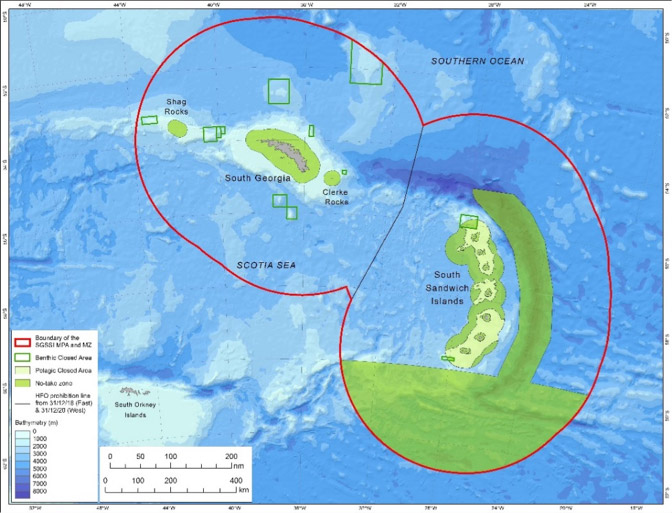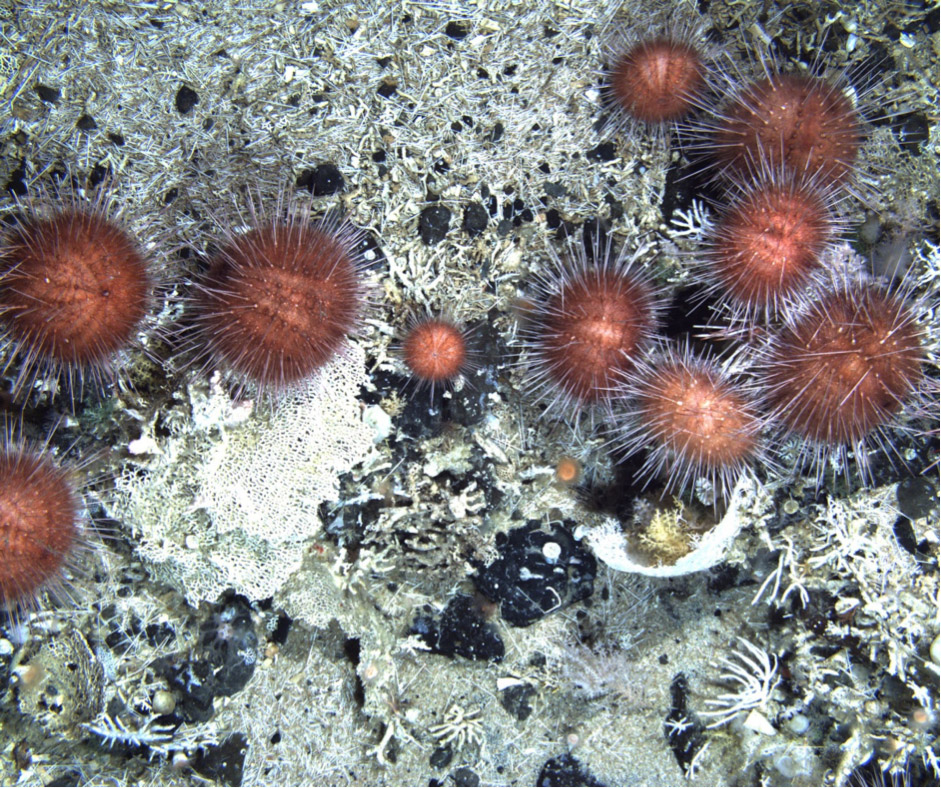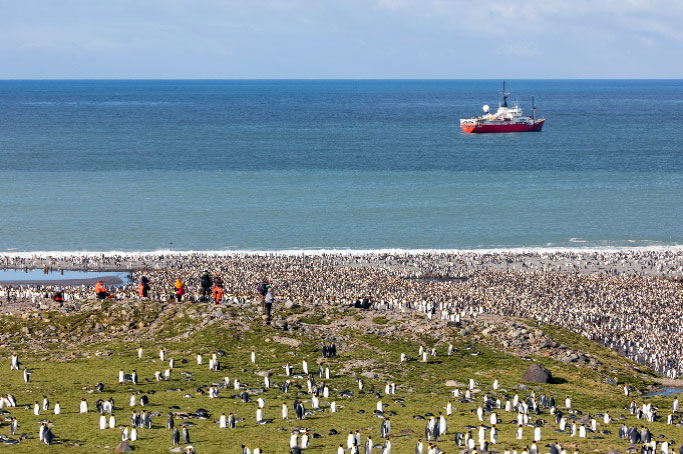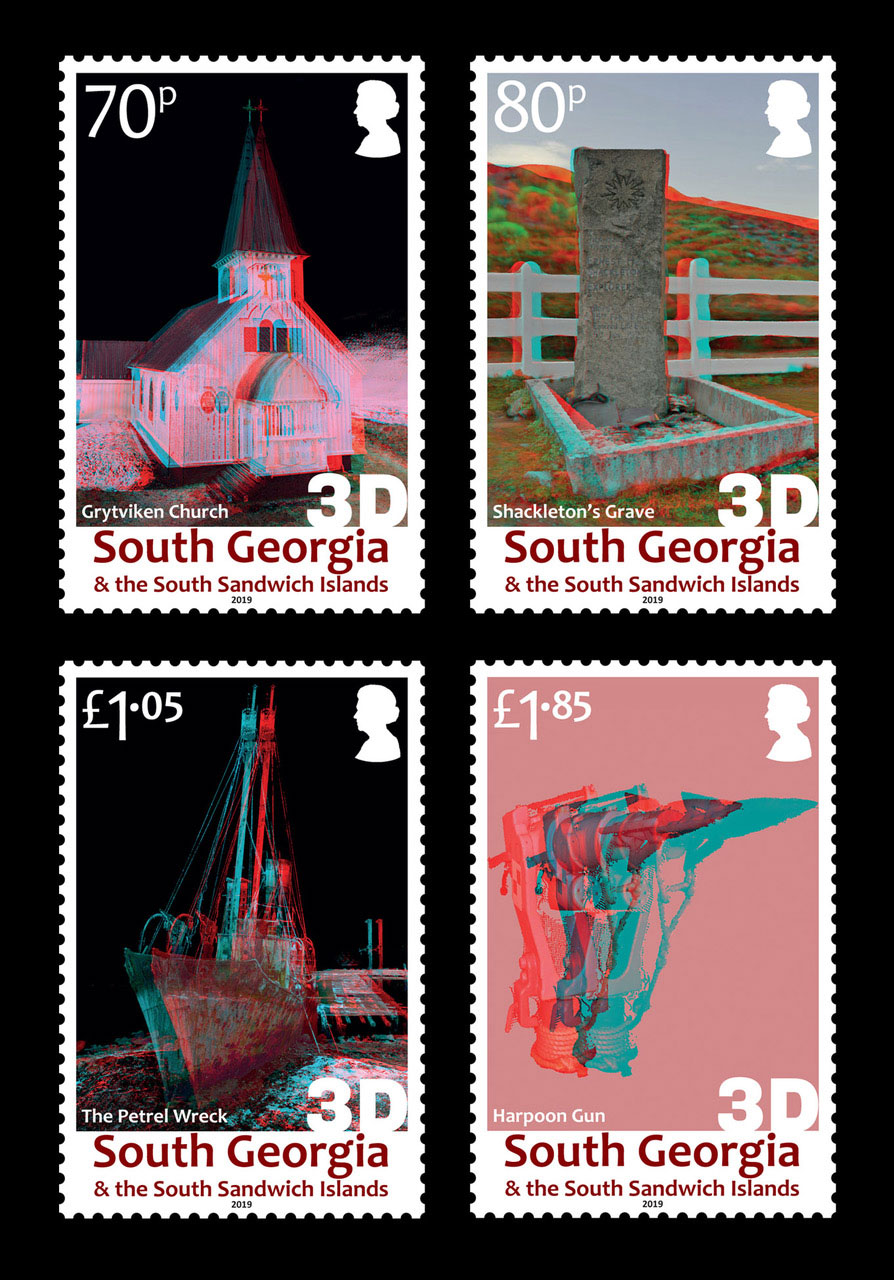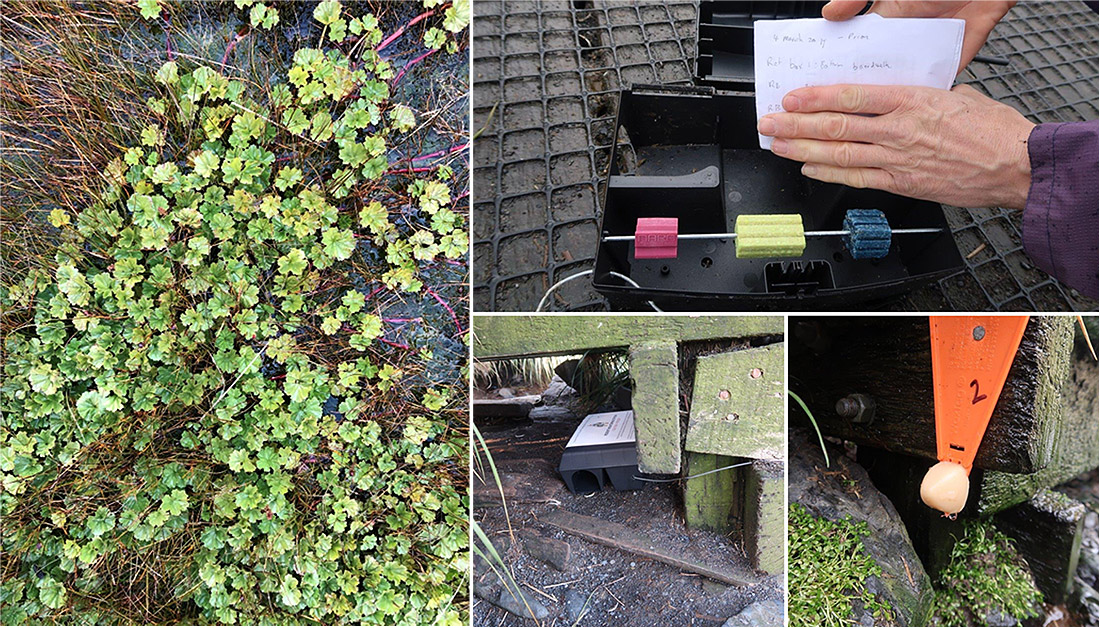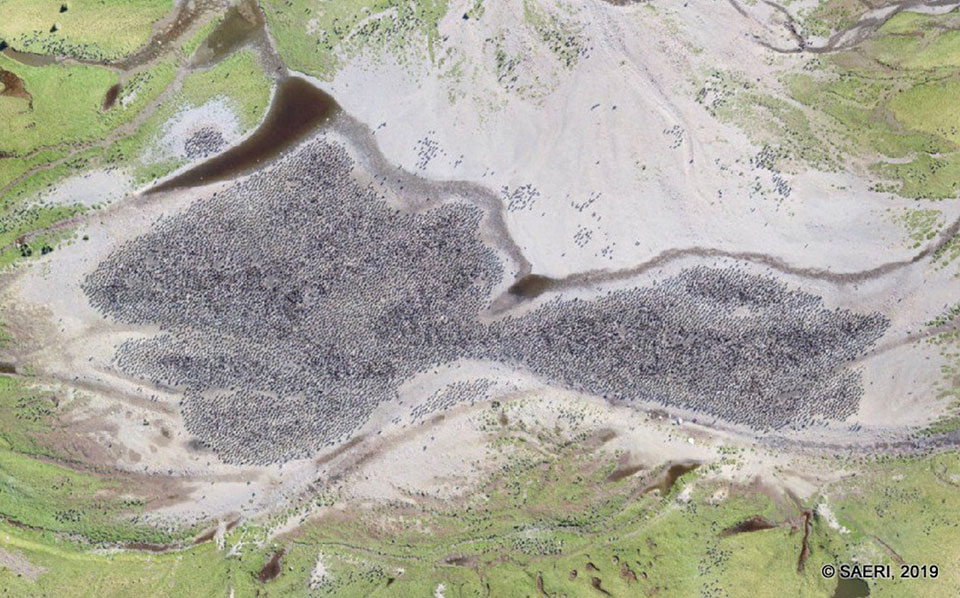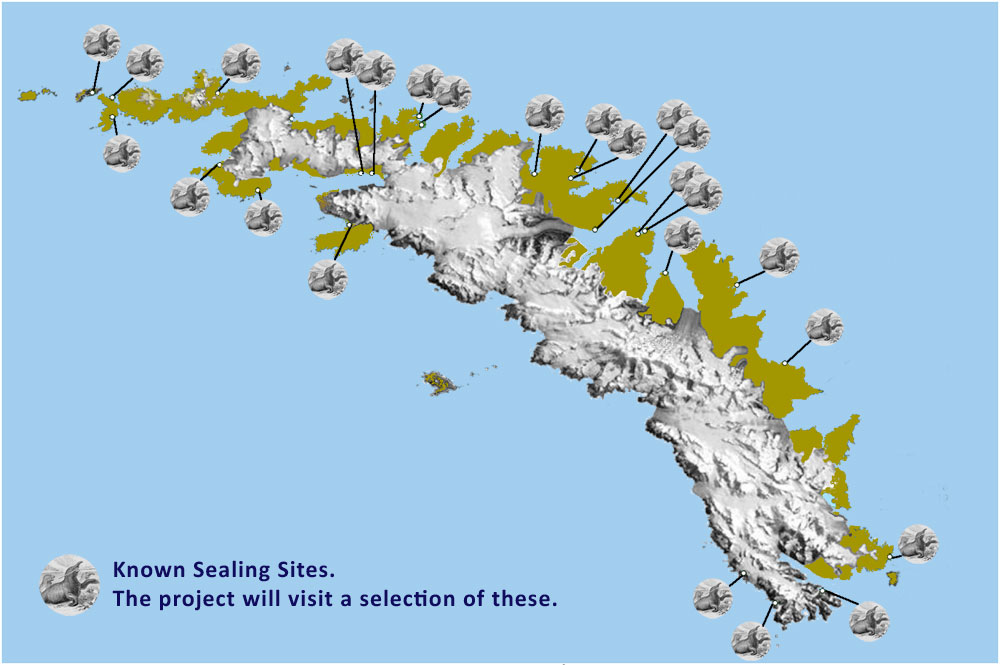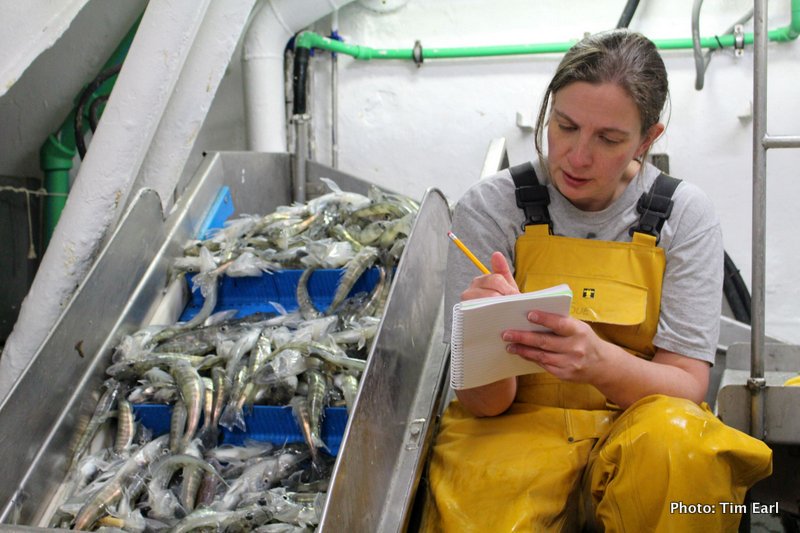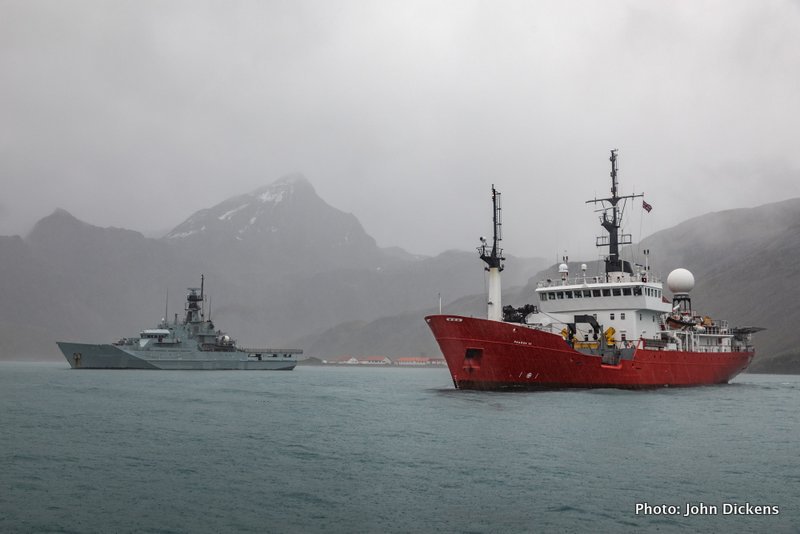February – June 2019
.
Following an announcement in December 2018, a suite of enhancements to the South Georgia & the South Sandwich Islands Marine Protected Area (SGSSI-MPA) have now been signed into legislation by HM Commissioner Nigel Phillips CBE. The enhanced measures are designed to further conserve the rich biodiversity found within the ocean surrounding this sub-Antarctic UK overseas territory. The new measures build on the existing MPA designated in 2012 and are based on scientific evidence considered during the first 5-year review of the MPA.
The enhanced measures include a large increase in the proportion of the 1.24 million km2 MPA within which all commercial fishing activity is prohibited. No-take zones now cover over 23 % of the MPA (284,000 km2), an area far exceeding the size of the UK. The no-take zones protect the most biodiverse habits found within the Southern Ocean and also includes the largely unexplored 8000m deep South Sandwich Islands trench – the deepest part of the South Atlantic.
In order to further reduce competition for resources between the fishery for Antarctic krill and the abundant populations of krill-dependent predators such as penguins, fur seals and flying seabirds, the closed season has been extended by two months across all 1.24 million km2 of the MPA. This seven month closure prevents overlap between the fishery and predators during the key part of their breeding season when their foraging ranges are restricted.
The SGSSI-MPA coupled with the territory’s world leading ecosystem based sustainable fisheries management, makes a substantial contribution to both global sustainability goals and to the UK’s Blue Belt programme, supporting delivery of the UK government’s commitment to provide long term protection for the marine environment.
Download the full News Release here [.pdf .4mb]
An £8.15 million contract to build a new wharf at the remote Sub-Antarctic Island of South Georgia has been awarded to BAM Nuttall. The contract is part of a major investment programme to modernise the UK’s Antarctic infrastructure.
Commissioned by the Natural Environment Research Council (NERC) and the Government of South Georgia & the South Sandwich Islands the wharf will enhance the safety and efficiency of ship operations at King Edward Point (KEP) Research Station (KEP). Construction work on site is envisaged to be undertaken between January and May 2020. Site supervision, engineering and project management support is being provided to BAS by its Technical Advisor Ramboll.
The station, owned by GSGSSI and operated by British Antarctic Survey, provides critical research to support sustainable management of the marine environment and living resources in this biodiversity hotspot in the Southern Ocean. The wharf, concept design by Ramboll and engineered design by BAM, will see the existing structure extended to last another 50 years, and an additional “dolphin” added – an 11m x 11m outpost off the main wharf, this will provide the extra capability required to berth the new polar research vessel the RRS Sir David Attenborough.
The wharf will also be compatible with the GSGSSI fishery patrol vessel Pharos SG the Royal Navy ice patrol ships. BAS researchers at KEP will use the wharf and slipway to operate Government harbour patrol boats, rigid inflatable hull boats (RIBs), scientific survey boats and workboats.
Engineering consultancy Ramboll and construction expert BAM were chosen to partner with British Antarctic Survey to modernise UK Antarctic and other research facilities, enabling British scientists to continue delivering world class research into some of the most important issues facing our planet. This is the second South Georgia project for the companies. Last year they successfully completed the refurbishment of nearby BAS Bird Island Research Station.
Surrounded by spectacular scenery, dominated by mountains and glaciers the Sub-Antarctic island of South Georgia is an important haven for wildlife. Research and monitoring conducted there helps to underpin the sustainable management of the territory’s marine environment which includes ecosystem-based fisheries management with catch limits agreed internationally by the Commission for the Commission for the Conservation of Antarctic Marine Living Resources (CCAMLR) and protection provided by a 1.24 million km2 Marine Protected Area (MPA).
King Edward Point Research Station lies at the entrance to King Edward Cove, a small bay within Cumberland East Bay, which is situated mid-way on the northern coast of South Georgia. It is about 1,400km (860 miles) south-east of the Falkland Islands. South Georgia is around 170 km long and between 2 km and 40 km wide, with its highest point being Mount Paget (2,960m) in the Allardyce range. Access to the islands is by ship only.
The Antarctic Infrastructure Modernisation (AIM) Programme will transform how British Antarctic Survey enables and supports frontier science. Commissioned by the NERC, this long-term programme will enable a world-leading capability to ensure that Britain remains at the forefront of climate, biodiversity and ocean research in the Polar regions. Together with the commissioning of the RRS Sir David Attenborough, this modernisation programme represents the largest UK Government investment in polar science infrastructure since the 1980s.
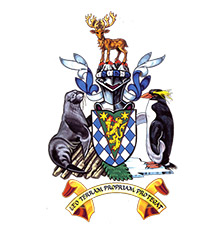 GSGSSI have published its audited 31 December 2017 financial accounts. They show an operating surplus of over £1.3m which will be used to support GSGSSI in meeting its stretching strategic objectives as identified in the SGSSI Strategy and help ensure compliance with rigorous conservation measures.
GSGSSI have published its audited 31 December 2017 financial accounts. They show an operating surplus of over £1.3m which will be used to support GSGSSI in meeting its stretching strategic objectives as identified in the SGSSI Strategy and help ensure compliance with rigorous conservation measures.
The Financial Statements can be downloaded here.
The Commissioner for South Georgia & the South Sandwich Islands, Nigel Phillips CBE, returned in mid March from his visit to this UK Overseas Territory where he has been accompanied by representatives of some of South Georgia’s key partners and stakeholders.
The visit took in various landing sites all facilitated by the Government’s vessel MV Pharos SG. Before we could feast our eyes on the abundant wildlife the fisheries patrol vessel undertook a fisheries patrol to the Southern Sea Mounts following the sighting of an unmarked buoy. Despite disrupting the visit as planned, the interruption served as a timely reminder to all aboard that the principal use of the MV Pharos SG is fisheries patrol. Having the ability to investigate such reports swiftly goes hand in hand with being one of the world’s best managed fisheries.
The Commissioner brought together guests involved in supporting the Government’s stewardship of the Islands including scientists, researchers, media and our post office provider. With the focus on stewardship we visited, amongst other places, Bird Island to learn about the long term monitoring of Albatross and to marvel at these magnificent animals. The summer team gave an excellent talk about the science undertaken and the new facilities on site. This provided useful context when compared against the facilities at King Edward Point.
Participants arrived at the administrative centre King Edward Point, carried out the required bio-security scrutiny and were given a science tour of the research station. Later that day the Commissioner and the Director of British Antarctic Survey, Dame Jane Francis, held a question and answer session for all those staying at King Edward Point or Grytviken. The guests had a chance to visit the museum and take a tour seeing the whaling station up close together with the stark stories of exploitation.
The wow factor for most of the guests was certainly provided for the charismatic mega fauna; penguins, seals and whales but we were all surprised by the abundant charismatic micro flora that was expertly explained by our guest from Kew. It was evident that looking holistically at the impact of habitat restoration was imperative if we are to realise the full potential from the hard work and dedication that went into both the reindeer and rodent eradication. It was thrilling to learn, from those on the trip who have visited South Georgia before that South Georgia Pipit was more abundant and that flora was responding to no grazing animals.
The Commissioner was grateful to all the participants of the visit who gave a significant amount of their time to travel to South Georgia. Having stakeholders who go home with passion about South Georgia helps create ambassadors in organisations who understand what we are trying to achieve and how their organisations may be able to help. This trip has certainly started a lot of conversations but the hard work is only just beginning.
GSGSSI is proud to support science that contributes to upholding best-practice environmental management and good governance of the Territory. The Goverment are therefore delighted by the announcement of the recent Darwin Initiative funding and welcome applications that will support the broader aims of the Government.
To allow GSGSSI to consider requests for support we require the following:
1. Completed Darwin application form
2. Separately identified details of support being requested such as (not exhaustive list) Project Partner, Funding, Letter of Support, Logistics, Staff Time, Accommodation or Boat time
3. Details of how GSGSSI will be included in any outreach and PR and how that supports Government.
4. Written motivation outlining how this project aligns with GSGSSI goals or builds on previous scientific endeavour.
These documents should be submitted to GSGSSI at admin(at)gov.gs no later than 10 working days prior to the submission deadline (dates below). Except in exceptional circumstances will not be able to support or prioritise submissions made later than this deadline.
Requests for support must be with GSGSSI no later than:
Darwin Main Project Stage1 Applications*– 2nd July
Darwin Fellowship – 22nd October
Darwin Partnership Awards – 22nd October
* Please note that for Darwin Main Project funding, it is important applicants provide GSGSSI with as much information as possible at the stage 1 application phase. If invited to submit a stage 2 application, GSGSSI will invite applicants to provide further details as the project develops. Projects that have not sought to engage GSGSSI during phase 1 will not be eligible to receive a letter of support for phase 2.
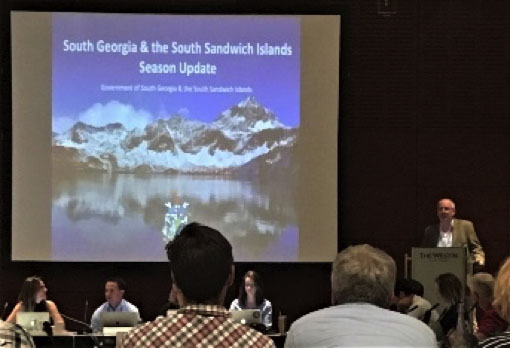
Her Majesty’s Commissioner, Nigel Phillips CBE, introduced the GSGSSI presentation at this year’s IAATO AGM held in Cape Town between the 1st and 3rd May 2019. The Commissioner spoke about GSGSSI’s mantra of evidence-based decision making, preparations for growing number of visitors, and the importance of collaboration and development of strategic relationships with IAATO as a way to achieve our aims.
GSGSSI’s Visitor Management Officer, Ross James, went on to deliver a presentation updating members on key events from the past season, which showed that yet again South Georgia received a record breaking number of visitors, and with the collaboration of visitors and expedition staff, managed to achieve an excellent standard of biosecurity, ensuring that visits were safe, responsible and environmentally sensitive. The presentation also hinted at some exciting future plans including the progress of the biosecurity detector dog programme, and work to assess key sites on South Georgia for future visitation. A full transcript of the presentation is available here.
The meetings were hugely positive, and the GSGSSI team were heartened to learn about some of the excellent work being undertaken by IAATO, operators and other stakeholders to further our collective understanding and stewardship of the region. One exciting example was a unanimous vote to introduce mandatory measures to help prevent whale strikes in cetacean-rich Antarctic waters.
A new stamp issue, which gives audiences a new perspective on Grytviken, was released on 10th May.
A hundred years ago, commercial whaling came to South Georgia. Carl Larsen pioneered shore based facilities to process their catch. The industry thrived and whaling stations grew from a cluster of a few buildings to small towns housing hundreds of workers complete with factories, accommodation, cinemas, sports facilities, cemeteries and churches. However, after only a few decades, the numbers of whales dwindled and the demand for the products made from them dropped off. By the mid-1900’s the whaling stations had largely fallen silent. Over the subsequent years, the sub-Antarctic climate slowly broke down the stations and with it the history and memories that went with them.
Although nothing can stop the advance of time and the ravages of the South Georgia weather, new technologies mean that the whaling stations and some of the stories associated with them can be captured in detail like never before.
The Government of South Georgia & the South Sandwich Islands along with the Norwegian Directorate for Cultural Heritage commissioned New Zealand company, Geometria, to carry out ground breaking work. Geometria used LIDAR or laser scanning technology along with photogrammetry and drone footage to systematically map the stations inside and out. The laser scanning was achieved by setting up tripod mounted laser arrays within the whaling stations and then by taking distance measurements in all directions. This meant they were able to capture the 3D surface of the buildings and landscapes in breathtaking detail.
A scan of a single building creates millions of data points so when the data from all the buildings of the former whaling stations was put together the result was one of the largest data sets of its type in the world containing over 10 billion data points. Processing this amount of information and putting it into a format accessible to members of the public was no small job. A UK based company called Shadow Industries used next generation video game rendering technology to create an application which allowed users to navigate through the whaling station using interactive touch screen displays. These specialist displays also incorporate short films from interviews with former whalers and historic photos. They have been installed in Norway, the Falkland Islands and South Georgia.
The incredible data from the laser scans is vital to facilitate better long-term understanding and management of the whaling stations and help tell the story of the whaling stations history.
The stamps included in this set show some examples of the 3D datasets, presented in anaglyph 3D. To view these stamps in 3D, red-cyan anaglyph glasses are required. Please note that the ability to view these images in 3D may be limited by some individuals’ eyesight.
70p – Grytviken Church
Built in 1913 and consecrated on Christmas day in the same year, the whaler’s church at Grytviken was a key feature of the whaling station. The church is in the neo-gothic style and has a single nave and a small library to the rear. The church fell into disrepair after the abandonment of the station but was repaired to its former glory in the 1990’s and is now an important site for visitors.
80p – Shackleton’s Grave
Possibly the most famous resident of the Grytviken cemetery, the remains of the explorer Ernest Shackleton were laid to rest on South Georgia in 1922 after he suffered a fatal heart attack. Although initially there were plans to return the body of the veteran of the Imperial Trans-Antarctic Expedition to Britain, his wife Emily requested he be buried on South Georgia.
£1.05 – The Petrel Wreck
Built in Oslo in 1928 the 35m former whale catcher is an iconic part of the Grytviken sky line. Powered by triple expansion coal fired steam engines and equipped with a bow mounted harpoon gun connected to the bridge via a cat walk, the Petrel was once cutting edge technology and allowed whalers to capture fast moving blue and fin whales.
£1.85 – Harpoon Gun
Harpoon guns were once a common site on South Georgia. Mounted on the bows of whale catchers, they made it possible to fire explosive harpoon shells deep into the flesh of the whale. Sharp spikes prevented the harpoon from sliding out and later versions of shells injected air to keep the carcass afloat and make it easier to tow the whale back to the ship. A graphic reminder of the whaling stations past.
GSGSSI is seeking the recruitment of a Finance, Administration and Logistics officer (FALO). This role will primarily support the financial and administrative functions of the Government, working with the Chief Executive to deliver a balanced budget and also working with the Operations Director on logistics relating principally to our fisheries patrol vessel.
The role is based in Stanley and is being offered on a 2 year contract. Further details and how to apply download here [.pdf].
With such a large and unpopulated island like South Georgia, it is the visitors who play a crucial role in alerting authorities to potential non-native species, and GSGSSI is interested in maximising this potential for visitors to play an intrinsic part of our monitoring and management of the island. A couple of examples this season have highlighted how visitors (now surpassing 10k per annum in number) can be our eyes on the ground.
A new plant species was found near Stromness this season, as part of a citizen science ‘bioblitz’. The plant belongs to the Gunnera genus but has yet to be identified further. We are still not sure if it’s a non-native species which has recently arrived, or a new record for a native species which has until now gone undetected. It is hoped that DNA analysis and further research might help answer these questions.
Another example was a potential rodent sighting by a cruise ship passenger. The visitor glimpsed what they thought could have been a rodent during a landing on Prion Island. Though they only saw it for a brief moment, the way it scurried made them think it could have been a rodent, but it was soon lost amongst the tussac grass.
GSGSSI take all sightings and reports seriously, and act according to our rodent incursion plan. In this case a thorough inspection of the area revealed no signs of rodent activity, but to be sure a number of passive rodent monitoring devices were deployed on Prion Island, including a smorgasbord of toxic and non-toxic baits and rodent attractants. At the end of the monitoring period, GSGSSI re-visited Prion Island and retrieved the devices. It was a great outcome that none of the devices bore any signs of rodent activity, and we are confident that the sighting was a case of mistaken identity. GSGSSI have received many similar mistaken reports in the past, which with the use of infra-red cameras, have been attributed to Pintail ducklings which move quickly through the tussac grass and can easily be mistaken for a rat.
These records are a fantastic illustration of how citizen science can be valuable in monitoring South Georgia’s flora and fauna. GSGSSI welcomes and encourages visitors to report potential sightings of rodents and other non-native species. We understand that even the most experienced people may be mistaken, but in the event of a sighting being validated, a rapid response increases our chances of successfully dealing with the incursion.
Coastal Habitat Mapping Of The Falkland Islands And South Georgia
(By the South Atlantic Environmental Research Institute. Read the full article here.)
Creating the first coastal margin habitat maps for the Falklands and South Georgia from high-resolution satellite imagery.
Our coastal areas are of critical importance to both humans and wildlife, and knowledge of them is essential for their management and conservation. Historically in the South Atlantic, the coastal margins of the Falkland Islands and South Georgia have been subject to relatively little study. However, the Falklands have received increased pressures over recent years from shipping, tourism and oil production. While South Georgia has received less human impact, it is still home to globally important populations of marine birds and mammals, and their habitat extends around its coastline.
This new project seeks to utilise recently available satellite imagery alongside other spatial data and local expert knowledge to develop the first broad-scale coastal margin (terrestrial, intertidal and subtidal) habitat maps for the Falkland Islands and South Georgia. Where there is significant uncertainty in these broad-scale maps, or in response to specific priorities from stakeholders, higher resolution habitat maps utilising very high-resolution satellite imagery or bespoke imagery captured using aerial drones will also be developed. These habitat maps will create an essential baseline, providing a sound basis for use in future planning, decision-making and monitoring.
This ambitious three-year project, due to conclude in March 2020, is truly an international collaboration and brings together expertise from a range of organisations across the globe. Together SAERI, Oregon State University, the UK Joint Nature Conservation Committee, Shallow Marine Surveys Group, Falkland Islands Government and Government of South Georgia & the South Sandwich Islands represents the leading edge in remote sensing, ecological knowledge and field expertise. The project is grant-aided by the Darwin Initiative through UK Government funding.
Albatross and petrel habitat preferences and foraging behaviour, and implications for fishery bycatch mitigation
Seabirds are amongst the most globally-threatened of all groups of birds, and albatrosses and large petrels (Macronectes and Procellaria) are of particular conservation concern, as 19 out of 29 species are listed as threatened by IUCN. These seabirds cover incredible distances when searching for food, and when migrating, which unfortunately brings them into contact with a wide range of threats. Incidental mortality (bycatch) associated with commercial fishing activities presents the greatest danger at-sea, but other issues such as climate change, disease, predation by introduced species or pollution can also have important negative impacts. Understanding where and when seabirds feed is an important step in establishing which pressures they are facing at-sea, and which areas are important to their well-being.
My name is Caitlin Frankish and I am a PhD student researching seabird movement in a collaboration between the British Antarctic Survey, University of Cambridge, and GSGSSI. My project aims to fill some of the gaps in our knowledge regarding the foraging behaviour and habitat use of albatrosses and petrels breeding on Bird Island, South Georgia, with a particular focus on black-browed and grey-headed albatrosses, and white-chinned petrels. Bird Island holds globally-important populations of these three species, which have been declining in numbers since the 1970s because of bycatch in commercial longline and trawl fishing operations. Although bycatch in the waters surrounding South Georgia has been reduced to negligible levels because of successful mitigation measures, the birds are still at risk from fisheries further afield, and the complex impacts of global change.
Successfully protecting these vulnerable birds relies on a complete picture of distribution and behaviour at the population level. An impressive two decades of remote-tracking studies have provided a wealth of data on adults, but details of the complex interaction between the intrinsic characteristics of the bird (age, sex, breeding status) and external environmental conditions (availability and distribution of prey), and implications for fisheries overlap and therefore bycatch risk remain under-studied. Nor has there been much research to date on the movements, habitat use and fisheries interactions of juveniles. In a first instance, I hope to understand whether age plays an important role in determining these birds’ foraging strategies, and what the implication of these differences may be for the improved management of their populations.
I have started by investigating whether the age and sex of black-browed and grey-headed albatrosses has an impact on their foraging patterns during the breeding season. This is an energetically-expensive time for parents, as they must alternate shifts fasting on the nest while incubating their clutch, and then feed both themselves and they’re young once their eggs hatch. I expect that age-specific differences in experience and physical fitness will have most influence on foraging patterns of inexperienced breeders and very old breeders. In turn, these age groups may be disproportionally impacted by poor environmental conditions and other threats if they are less efficient foragers or differ in their at-sea distributions.
This (austral) summer, I am spending three exciting months on New Island in the Falklands to observe one of my study species in the field, and to learn more of the practicalities of collecting tracking and other monitoring data. I have helped to deploy GPS devices on breeding black-browed albatrosses on the island, and now I am monitoring their chick survival. It is a great privilege to watch these birds in their natural habitat, and especially to follow the chicks’ progress from one day to the next. The breeding populations of black-browed albatross in the Falklands are doing relatively well in comparison to those on South Georgia, and hopefully, the long-term study running on this island will help us understand why this may be.
When I return to Cambridge, I will focus on analyses of the initial dispersal movements of juvenile grey-headed albatrosses and white-chinned petrels when they leave the nest for the first time. Very few datasets exist on the distribution of this fascinating life-stage due to logistical and other difficulties. Indeed, juveniles leave the colony unaccompanied by their parents, and it is several years before they return for the first time. The period from independence to recruitment into the breeding population is a critical life-history stage, during which naïve individuals learn how and where to forage over many years, and unaided by their parents. I hope to understand how foraging behaviour develops in these young birds and whether higher juvenile than adult mortality rates in these species can be explained by poor foraging ability, differential habitat use or greater overlap with threats from fisheries.
During the months of February and March, the South Georgia Archaeological Project 2019 (SGAP) has been full steam ahead. The project, developed by the South Georgia Heritage Trust, is part of their programme to conserve the island’s heritage and add to historical records.
You can follow their progress on Twitter and watch out for exciting announcements on the SGHT website.
South Georgia scientist and one of Antarctica’s greatest champions, Professor David Walton, has passed away.
Article by BAS:
 It is with great sadness that we report the death of Emeritus Fellow, Professor David Walton. David was an ecologist in BAS for over 40 years since 1967. He was head of terrestrial biology and then head of the Environment Information Division until his retirement. He had a long and distinguished career in BAS and was recognised for his Antarctic expertise worldwide.
It is with great sadness that we report the death of Emeritus Fellow, Professor David Walton. David was an ecologist in BAS for over 40 years since 1967. He was head of terrestrial biology and then head of the Environment Information Division until his retirement. He had a long and distinguished career in BAS and was recognised for his Antarctic expertise worldwide.
David was incredibly active in many areas of Antarctic science and policy, in particular for SCAR. In 2006 he was the recipient of the SCAR Medal for International Scientific Coordination and represented SCAR in many Antarctic Treaty Consultative Meetings. He was the Chair of SCAR’s Group of Specialists on Environmental Affairs and Conservation, and editor of the SCAR Antarctic Environments Portal. He was involved in many Antarctic Treaty Consultative Meetings as Chief Editor of the annual report.
He was Editor in Chief of the scientific journal Antarctic Science, which he established in 1989, and has contributed to, compiled and edited six books on research in Antarctica. He was Chief Scientist on the recent Antarctic Circumpolar Expedition (ACE) and was advisor to the forthcoming GLACE scientific expedition to Greenland with the Swiss Polar Institute – and so many more activities in the Antarctic community.
David was dedicated to Antarctica and polar science. He has very many friends across BAS and the international Antarctic community who will miss him greatly.
Our thoughts are with his wife Sharon and their three children.
Wildlife and change on the frozen continent
Ross Dinyari will discuss his most recent trip to Antarctica, South Georgia and the Falkland Islands Friday, June 7, at 7 p.m. at the Jesup Memorial Library.
Biodiversity threat won’t be tackled by alarmist biologist hype and dismantling capitalism
This is a specific problem that can be tackled and reversed, but it will take technology and science and money, not retreating into self-sufficiency and eating beans. The eradication of rats on South Georgia island was a fine example of doing this right, with helicopters, GPS and a lot of science.
Compassionate conservation is ‘seriously flawed’
In South Georgia, an island in the southern Atlantic, the population of rats were culled in order to protect endangered bird species, such as the albatross.
Penguins Were a Lonely Explorer’s Best Friends
The Endurance left the Grytviken whaling station on South Georgia Island on December 5, 1914, and within two days, Frank Worsley, the ship’s master from New Zealand, was steering through sea ice.
The Past and Present of Whales In South Georgia
The past is very present in South Georgia. The Southern Hemisphere’s first industrial whaling station sits in Grytviken. The rusting red interior of the former processing plant, stripped of their asbestos filled outer shell, once processed dozens of whales per day. It was one of six land based and 13 floating whaling stations that once operated in South Georgia, which combined killed over 175,000 whales within a day’s sail of the island. The South Georgia Museum has done an amazing job preserving the artefacts from the village that used to be Grytviken and providing visitors with the historical context of the remaining structures.
How to save a species…
From problems to solutions. When rodents took over the South Georgia Island, they had a devastating effect on the number native rare birds. Izzie Clarke and Katie Haylor were joined by Dickie Hall from the South Georgia Heritage Trust who was a key member of an ambitious and successful project to save them.
Birth of Sir Shackleton commemorated by South Georgia with new crown coins
The government and treasury of the South Georgia & South Sandwich Islands issued on 26 February new crown coins that commemorate the birth of the famous explorer, Sir Ernest Shackleton.
South Georgia and South Sandwich Islands: Great Seal of Queen Victoria features on bicentenary anniversary crown coins
The government and treasury of South Georgia and South Sandwich Islands have issued (21st March) new crown coins and gold £4 pieces which are in celebration of the bicentenary anniversary of the birth of Queen Victoria.
Russia’s tall ships to undertake around-the-world expedition dedicated to 200th anniversary of discovery of Antarctic by Bellingshausen-Lazarev expedition
Milestone events during the expedition will be the meetings of the three ships in the Atlantic Ocean on the Ushuaia (Argentina)-Cape Town (South Africa) leg, in the area of the South Georgia and South Sandwich Islands (the UK), where the Pallada’s itinerary will reach its nearest point to the Antarctic.
10 of the least known islands you should visit to see wildlife
The shores of South Georgia Island are dominated by a massive king penguin population, with up to 300,000 found at St. Andrews Bay. Situated 1,300 miles east of Tierra del Fuego, this landmass with 9,000 feet of soaring snow-capped mountains tore from the Andes 50 million years ago, creating a rugged wilderness in the South Atlantic.
The remote island of South Georgia
Today’s Image of the Day from NASA Earth Observatory features the island of South Georgia, which is known for its rugged terrain and extreme environment. The uninhabited island contains 11 mountains that rise more than 6,500 feet above sea level and supports 161 glaciers.
The best job in the world? Meet the Antarctic guide who shares an ‘office’ with penguins
There is no doubt that Ernest Shackleton’s endeavours between April and August 1916 – when he sailed a lifeboat 800 miles across the southern Atlantic Ocean, crossed the remote frozen outcrop of South Georgia and returned to the even more distant Elephant Island to rescue his marooned crew – were among the most incredible feats of the Heroic Age of Antarctic Exploration.
A Year In The Life Of An Albatross
Thanks to cameras set up by the British Antarctic Survey on Bird Island, a small island off the coast of South Georgia near the Antarctic circle, we’re following four species of albatross — Wandering Albatross, Black-browed Albatross, Grey-headed Albatross and Light-mantled Albatross — as they find their mates, build their nests and raise their chicks.
Search for Shackleton’s lost Endurance ship called off
A UK-led expedition to the Weddell Sea sent a sub to the ocean floor to look for the sunken polar yacht, but this robot was itself lost in the process.
The team has now withdrawn from the area because of deteriorating weather and sea-ice conditions.
Remote South Georgia Island returns to ‘paradise for birds’ after rat-killing program, says Calgary naturalist
The result is profound. Right now, there are 53 million birds nesting on the various islands. They are estimating in the fairly near future that will increase by 100 million more birds. It will triple the population and turn the landscape back into a paradise for birds.
Share[addtoany]


